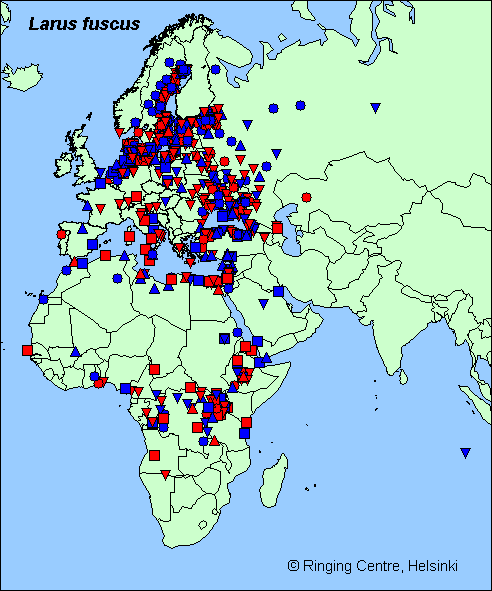 Ring
Recoveries
Ring
Recoveries
(last update: 10 oktober 2005)
Herring Gull argentatus
Herring Gull argenteus
Herring Gull smithsonianus
Great
Black-backed Gull marinus
Lesser B-b Gull
graellsii / intermedius
Lesser B-b Gull
fuscus
Yellow-legged
Gull michahellis
Yellow-legged
Gull atlantis
Caspian Gull cachinnans
Armenian Gull
armenicus
Baraba Gull barabensis
Heuglini's Gull
heuglini
Vega Gull
vegae
Mongolian Gull
mongolicus
Slaty-backed
Gull
schistisagus
.
Black-headed
Gull ridibundus
Grey-headed
Gull cirrocephalus
Brown-headed Gull
brunnicephalus
Bonaparte's
Gull philadelphia
Little Gull minutus
Mediterranean
Gull melanocephalus
Relict Gull relictus
Audouin's Gull audouinii
Slender-billed
Gull genei
Common / Mew
Gull canus
Ring-billed
Gull delawarensis
Franklin's Gull
pipixcan
Laughing Gull atricilla
Kittiwake Rissa
tridactyla
Ivory Gull Pagophila
eburnea
Ross's Gull Rodosthetia
rosea
Sabine's
Gull sabini
Great
Black-headed Gull ichtyaetus
Sooty Gull hemprichii
White-eyed Gull leucophthalmus
Glaucous
Gull hyperboreus
Iceland Gull glaucoides
Thayer's Gull thayeri
Kumlien's
Gull kumlieni
.
Mystery Gulls
Skua's Catharacta
/ Stercorarius
Terns Sterna
Other
Birds & Mammals
.
Home
Links
to Gullsites
Gull taxa
Gull Topography
Grey & Colour Charts
Locations in NW Europe
Summaries of Articles
About ORG
@
![]()
On this page we will add/plot ring recoveries of fuscus, intermedius and graellsii on a map to show the overlap and differences in migration routes and wintering locations. Locations of wintering grounds and breeding spots may be relevant to understand time schedules/patterns and moult strategy of the LBBG races. We use two maps (the world map and a map of Africa) downloaded from "The great globe gallery" and nice images of globes can be downloaded from http://hum.amu.edu.pl/~zbzw/glob/glob1.htm.
At Westkapelle, the Netherlands (see distribution), LBBGs can be found well into November. Readings of (metal) ringed LBBGs revealed some originate from Denmark, some from Sweden and some from S Norway. Although local Dutch individuals may occur as well, bulk of the 100's present LBBGs in November are probably Scandinavian birds. Large intermedius colonies can be found in Vest-Agder (S Norway, see more at the Adult July section) and this is the most northern colony from which ringed Scandinavian birds occur in the Netherlands. But though they may be seen in NW Europe well into November, others (from the same colony) proved to be much more adventurous.
For instance a long distance migrant, much in line with Finnish colour-ringed LBBG fuscus. It's a 1cy LBBG X, metal ringed Stavanger 472418 date July 5 1984 at Rauna, Farsund, Vest-Agder, Norway 58.03N 06.40E and shot October 18 1984 in Owando, Kongo 00.27S 15.44E, 6553 km to the south 3 months and 13 days later.
Some website already show recoveries of Lesser Black-backed Gull rings,
like:
Ligue
pour la Protection des Oiseaux Anjou from
France, with colour-ring recoveries of Dutch and English LBBGs;
a website with recoveries of Herring Gulls, Great Black-backed Gulls and
LBBG from Scandinavia, run by Kjeld
Pedersen;
and
the website by the Finnish
Ringing Centre, showing ring recoveries of Finnish fuscus
LBBG plotted in an European map.
Read all information at the European
Colour-Ring website, created by Dirk Raes from Belgium.
You can find various recoveries in the sections of this website, just
check out the sections for any "age-group + month". If you have
found a bird wearing metal rings, please check out the website of the BTO.
 Foreign
ring recoveries of Finnish Foreign
ring recoveries of Finnish Foreign
recoveries of Lesser Black-backed Gulls Larus fuscus ringed
as nestlings in Finland Age class when found: |

